Top Rankings
William S. Hart Union High School District ranks among the top 20% of public school district in California for:
Category
Attribute
Overall Rank
Highest overall rank (Top 20%)
Reading/Language Arts Proficiency
Highest reading/language arts proficiency (Top 20%)
Graduation Rate
Highest graduation rate (Top 5%)
Diversity
Most diverse schools (Top 1%)
Community Size
Largest student body (number of students) (Top 1%)
For the 2025 school year, there are 7 public middle schools serving 6,478 students in William S. Hart Union High School District. This district's average middle testing ranking is 9/10, which is in the top 20% of public middle schools in California.
Public Middle Schools in William S. Hart Union High School District have an average math proficiency score of 43% (versus the California public middle school average of 31%), and reading proficiency score of 66% (versus the 46% statewide average).
Minority enrollment is 68% of the student body (majority Hispanic), which is less than the California public middle school average of 78% (majority Hispanic).
Overview
This School District
This State (CA)
# Schools
16 Schools
3,501 Schools
# Students
20,653 Students
1,854,363 Students
# Teachers
941 Teachers
87,821 Teachers
Student : Teacher Ratio
22:1
22:1
District Rank
William S. Hart Union High School District, which is ranked #307 of all 1,925 school districts in California (based off of combined math and reading proficiency testing data) for the 2021-2022 school year.
The school district's graduation rate of 97% has increased from 94% over five school years.
Overall District Rank
#311 out of 1941 school districts
(Top 20%)
(Top 20%)
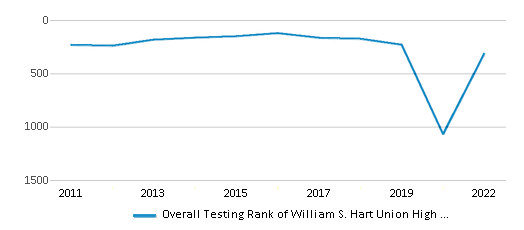
Math Test Scores (% Proficient)
41%
33%
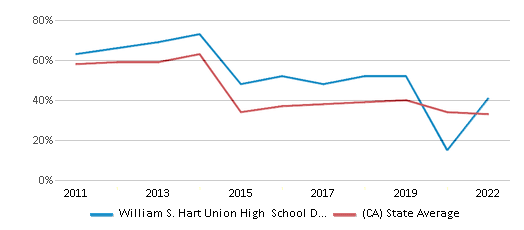
Reading/Language Arts Test Scores (% Proficient)
68%
47%
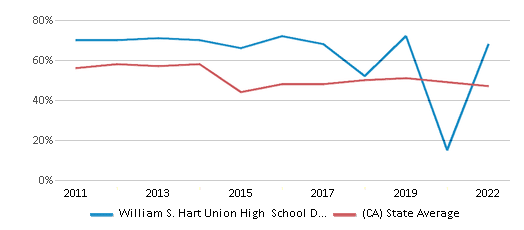
Science Test Scores (% Proficient)
44%
29%
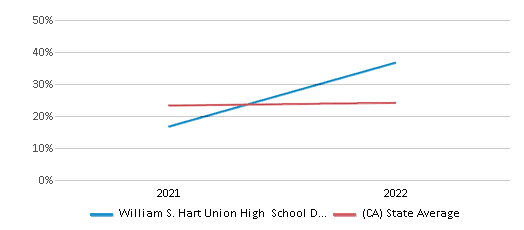
Graduation Rate
97%
87%

Students by Ethnicity:
Diversity Score
0.68
0.64
# American Indian Students
28 Students
9,887 Students
% American Indian Students
n/a
1%
# Asian Students
2,823 Students
201,760 Students
% Asian Students
14%
11%
# Hispanic Students
9,309 Students
1,009,980 Students
% Hispanic Students
45%
55%
# Black Students
879 Students
97,908 Students
% Black Students
4%
5%
# White Students
6,649 Students
413,325 Students
% White Students
32%
22%
# Hawaiian Students
37 Students
7,600 Students
% Hawaiian Students
n/a
n/a
# Two or more races Students
923 Students
109,003 Students
% of Two or more races Students
5%
6%
Students by Grade:
# Students in PK Grade:
-
83
# Students in K Grade:
-
90,358
# Students in 1st Grade:
-
70,728
# Students in 2nd Grade:
-
73,359
# Students in 3rd Grade:
-
73,090
# Students in 4th Grade:
-
76,068
# Students in 5th Grade:
-
82,191
# Students in 6th Grade:
-
289,122
# Students in 7th Grade:
3,048
439,549
# Students in 8th Grade:
3,116
441,705
# Students in 9th Grade:
3,386
59,696
# Students in 10th Grade:
3,535
51,846
# Students in 11th Grade:
3,680
51,149
# Students in 12th Grade:
3,888
55,419
# Ungraded Students:
-
-
District Revenue and Spending
The revenue/student of $21,204 is higher than the state median of $19,974. The school district revenue/student has grown by 5% over four school years.
The school district's spending/student of $15,499 is less than the state median of $18,396. The school district spending/student has grown by 5% over four school years.
Total Revenue
$438 MM
$116,387 MM
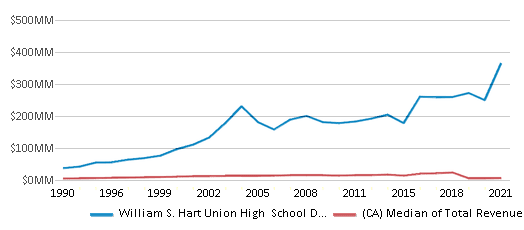
Spending
$320 MM
$107,188 MM
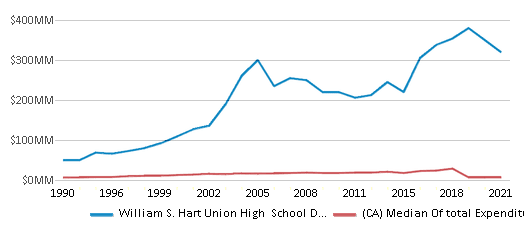
Revenue / Student
$21,204
$19,974
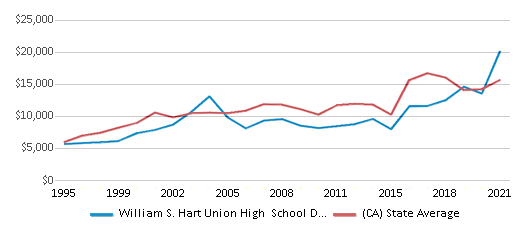
Spending / Student
$15,499
$18,396
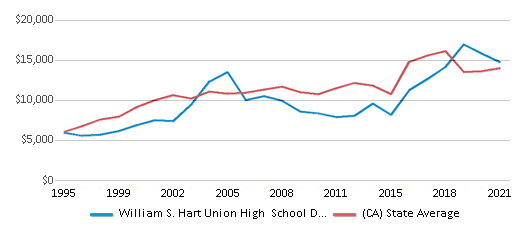
Best William S. Hart Union High School District Public Middle Schools (2025)
School
(Math and Reading Proficiency)
(Math and Reading Proficiency)
Location
Grades
Students
Rank: #11.
Rancho Pico Junior High School
(Math: 62% | Reading: 81%)
Rank:
Rank:
10/
Top 10%10
26250 West Valencia Blvd.
Stevenson Ranch, CA 91381
(661) 284-3260
Stevenson Ranch, CA 91381
(661) 284-3260
Grades: 7-8
| 848 students
Rank: #22.
Rio Norte Junior High School
(Math: 52% | Reading: 76%)
Rank:
Rank:
9/
Top 20%10
28771 Rio Norte Dr.
Valencia, CA 91354
(661) 295-3700
Valencia, CA 91354
(661) 295-3700
Grades: 7-8
| 1,110 students
Rank: #33.
Arroyo Seco Junior High School
(Math: 49% | Reading: 68%)
Rank:
Rank:
9/
Top 20%10
27171 North Vista Delgado Dr.
Valencia, CA 91354
(661) 296-0991
Valencia, CA 91354
(661) 296-0991
Grades: 7-8
| 1,240 students
Rank: #44.
Learning Post Academy (Alternative)
Alternative School
(Math: 40-44% | Reading: 65-69%)
Rank:
Rank:
8/
Top 30%10
24825 North Newhall Ave.
Newhall, CA 91321
(661) 255-8338
Newhall, CA 91321
(661) 255-8338
Grades: 7-12
| 363 students
Rank: #55.
Placerita Junior High School
(Math: 34% | Reading: 64%)
Rank:
Rank:
8/
Top 30%10
25015 North Newhall Ave.
Newhall, CA 91321
(661) 259-1551
Newhall, CA 91321
(661) 259-1551
Grades: 7-8
| 920 students
Rank: #66.
Sierra Vista Junior High School
(Math: 35% | Reading: 53%)
Rank:
Rank:
7/
Top 50%10
19425 West Stillmore St.
Canyon Country, CA 91351
(661) 252-3113
Canyon Country, CA 91351
(661) 252-3113
Grades: 7-8
| 974 students
Rank: #77.
La Mesa Junior High School
(Math: 30% | Reading: 53%)
Rank:
Rank:
7/
Top 50%10
26623 May Way
Canyon Country, CA 91351
(661) 250-0022
Canyon Country, CA 91351
(661) 250-0022
Grades: 7-8
| 1,023 students
Recent Articles

What Is A Charter School?
Explore the world of charter schools in this comprehensive guide. Learn about their history, how they operate, and the pros and cons of this educational innovation. Discover key facts about charter schools, including admission policies, demographics, and funding, as well as what to look for when considering a charter school for your child.

10 Reasons Why High School Sports Benefit Students
Discover the 10 compelling reasons why high school sports are beneficial for students. This comprehensive article explores how athletics enhance academic performance, foster personal growth, and develop crucial life skills. From improved fitness and time management to leadership development and community representation, learn why participating in high school sports can be a game-changer for students' overall success and well-being.

February 05, 2025
Understanding the U.S. Department of Education: Structure, Impact, and EvolutionWe explore how the Department of Education shapes American education, from its cabinet-level leadership to its impact on millions of students, written for general audiences seeking clarity on this vital institution.





